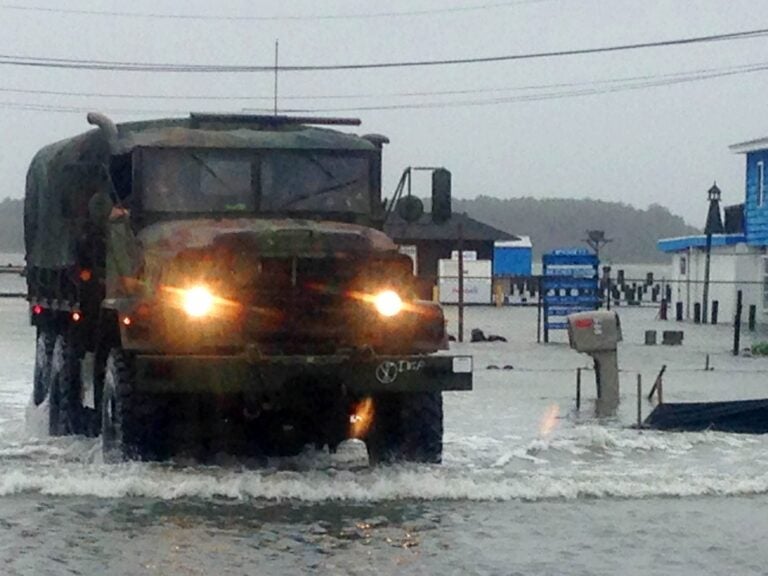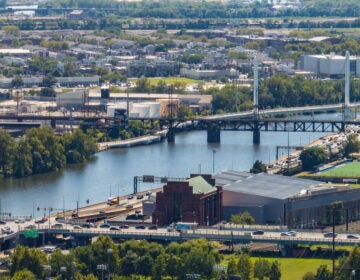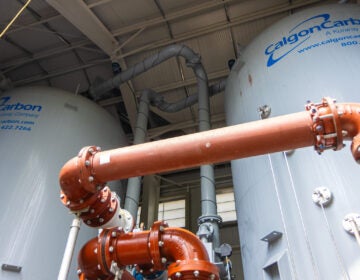Rising seas puts hundreds of Superfund sites at risk, study says
More than 200 current and potential Superfund sites in Pennsylvania and New Jersey are at risk of flooding in the next 20 years due to sea-level rise.

Tidal flooding like this in Dewey Beach, Del. will become more common with sea-level rise, scientists warn. (Randall Chase/AP Photo)
This article originally appeared on StateImpact Pennsylvania.
—
More than 200 current and potential Superfund sites in Pennsylvania and New Jersey are at risk of flooding in the next 20 years due to sea-level rise, according to a new report from the Union of Concerned Scientists.
The report, “A Toxic Relationship, Extreme Coastal Flooding and Superfund Sites,” says the Trump Administration’s EPA is shirking its responsibility to warn the public and protect public health.
“The information has been suppressed for so long and you have communities that are at risk and until this information is out there, these communities are going to remain at risk,” said Jacob Carter, a former EPA researcher and author of the report.
Only the most dangerous and toxic industrial sites end up on the Superfund list, and they include contamination from hazardous materials like volatile organic compounds, PCBs or lead.
New Jersey leads the nation in the number of Superfund sites – and the report found 188 current and proposed sites along the coast are at risk of flooding over the next 20 years, based on a low rate of projected sea level rise. In Pennsylvania, 35 sites in the Delaware River watershed are at risk.
Carter began working at the EPA as a researcher during the Obama Administration, which issued an executive order in 2015 to use climate science in assessing future risks to Superfund sites. He developed a model and was close to finishing an analysis about the risks, but says it was never released. The Trump transition team at EPA was pushing to get rid of all references to climate change in the report, Carter said.
“So you might imagine how it’s difficult to take a report based on the climate -informed-science approach and try to get rid of every reference to climate change,” he said.
Trump rescinded the executive order that guided Carter’s work, and Carter left the agency soon after Trump entered office. Using the same model he developed at the EPA, Carter began working on a more comprehensive evaluation of Superfund flood risks as a research scientist with the Center for Science and Democracy at the Union of Concerned Scientists.
“I needed to get it out because the Trump Administration was going to suppress this work,” he said.
His research shows a disproportionate number of the highly dangerous hazardous waste sites are near communities of color and low-income residents.
“Millions of people of color and thousands of low-income households will be at risk from future flooding from these sites,” Carter said. “And that’s something that the agency can no longer sit on. There needs to be action now.”
Carter said the EPA needs to incorporate climate models into risk assessments and remediation plans. A similar report issued by the Government Accountability Office in November also warned of climate risks to Superfund sites and urged the EPA to do the same.
The EPA said it is reviewing Carter’s report, but takes issue with the number of sites listed along both the Atlantic and Gulf coasts.
The Union of Concerned Scientist’s report includes both active Superfund sites on the “National Priorities List,” as well as sites the EPA is reviewing. Some of the sites might never end up on the Superfund list.
“…The report greatly exaggerates the number of Superfund sites at risk of flooding by erroneously claiming that there are 10,000 Superfund sites,” wrote EPA spokeswoman Melissa Sullivan. “In the history of the Superfund program, if the number of deleted Superfund sites are added to the number of Superfund sites presently on the National Priorities list, there have been less than 2,000 Superfund sites.”
Sullivan said the EPA does take the issue seriously, and has taken measures to protect public safety and health.
“The EPA strongly believes the Superfund program’s existing processes and resources adequately ensure that risks and any effects of severe weather events, are woven into risk response decisions at nonfederal NPL sites,” she wrote. An EPA report from 2018 concluded that the 2017 hurricane season resulted in “minor damage.”
Sullivan defended the agency’s actions under President Trump, saying it is implementing the Superfund Climate Resilience Action Plan, which has recommended “encouraging interim and early action” regarding risks at the sites and “promoting adaptive management” in the face of changes to the sites.
“While EPA’s current efforts adequately address the risks and extreme weather events, the Agency continues to improve the Superfund Program to accelerate cleanups, protect human health and the environment, and transform communities.”
The report is not yet peer-reviewed. Carter says it was important to release it as hurricane season is in full swing.

Get daily updates from WHYY News!
WHYY is your source for fact-based, in-depth journalism and information. As a nonprofit organization, we rely on financial support from readers like you. Please give today.






